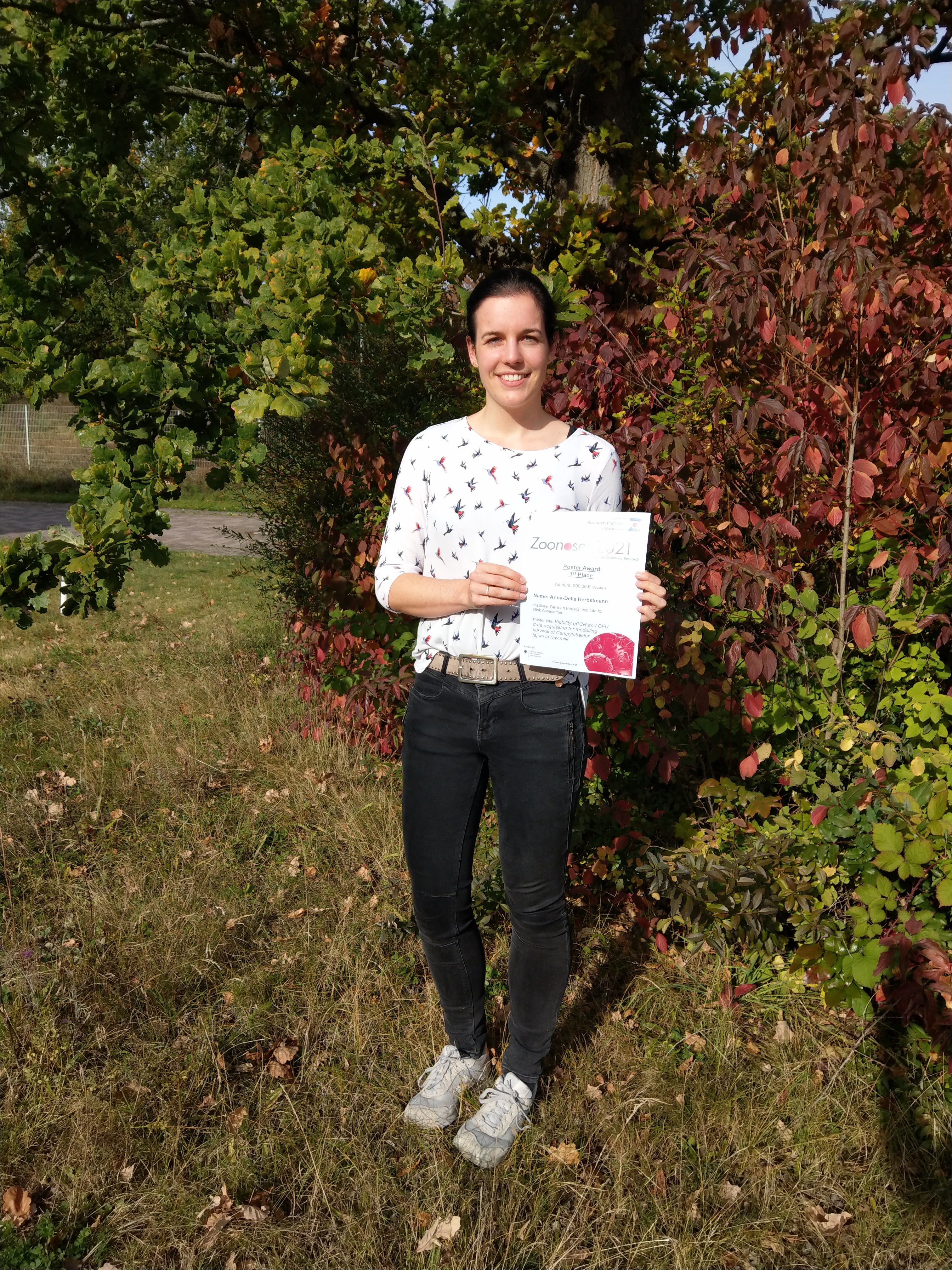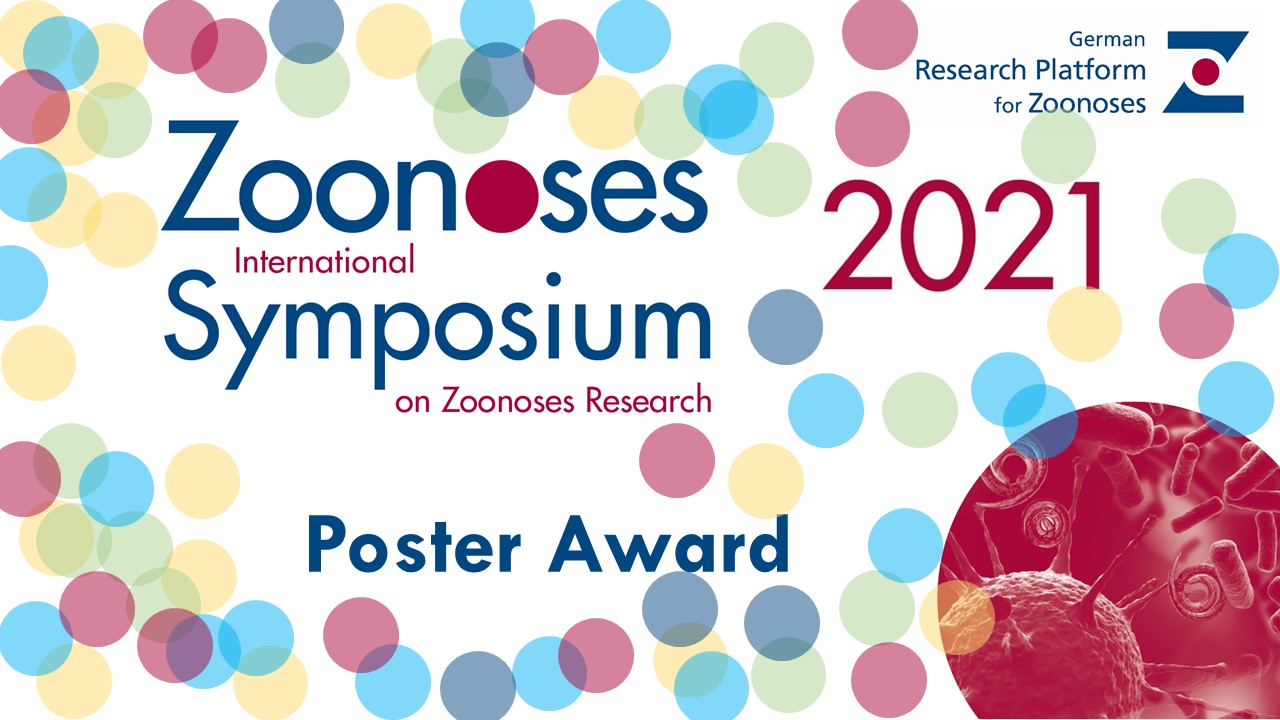The German Research Platform for Zoonoses organizes an annual symposium for scientific exchange within zoonoses research. During the symposium, the three best posters of young scientists presented in the poster exhibition and the poster slam at the event are selected and awarded by the participants. Below you will find a short interview with the first and second place winners of the 2021 Poster Award. An overview of the winners* of the last years can be found here.
1. Place Poster Award 2021
Anna-Delia Herbstmann (Bundesinstitut für Risikobewertung) Viability qPCR and CFU data acquisition for modelling survival of Campylobacter jejuni in raw milk
Ms. Herbstmann, in brief: What is your research, which you present in the poster, about?
The increased sale of raw milk by raw milk filling stations and the accompanying increase in consumption of raw milk raises the question of how well Campylobacter jejuni can survive in raw milk. In my poster, data on the survival of different C. jejuni strains in raw milk at 5 °C, 8 °C and 12 °C are presented. For this purpose, we used two different methods, cultural according to ISO 10272-2:2017 and a live qPCR (Wulsten et al., 2020), and compared the data.
What are the main findings of your work?
Campylobacter is able to transition a VBNC state where cells are viable but undetectable by cultural methods (viable but nonculturable). The infectivity of Campylobacter in the VBNC state is unknown in this context. With live qPCR, both the culturally detectable cells and the cells in the VBNC state are detected. The comparison of the two methods clearly shows that the survival of C. jejuni was underestimated by up to 4.5 log CFU in the cultural detection.
The underestimation has already been shown for 5 °C (Wulsten et al., 2020). We were able to reproduce these results and generated similar results at 8 °C and 12 °C.
And last but not least - What's next? Related to your research and career?
The generated data will be used in the next step to develop a predictive model for Campylobacter survival in raw milk. Here, the cultural data will be used as a "best-case scenario" and the live qPCR data will be used as a "worst-case scenario" as long as more accurate data on the infectivity of Campylobacter in the VBNC state is not available. Finally, this predictive model will be used in a quantitative risk assessment (QMRA) for C. jejuni along the commodity chain of raw milk.
I am a PhD student at the German Federal Institute for Risk Assessment (BfR) in the Department of Biological Safety in the junior research group " Warenkettenmodelle" and we work closely together with the National Reference Laboratory for Campylobacter at BfR. Currently, I have the unique opportunity to do a study abroad in Denmark at Statens Serum Institute under the supervision of Maarten Nauta, actively working on model development. I am also taking some courses on predictive microbiology and QMRA at the Technical University of Denmark (DTU).
Once again, congratulations on your first place, Ms. Herbstmann, and all the best for your future!
 Anna-Delia Herbstmann (BfR), winner of the Poster Award 2021 of the German Research Platform for Zoonoses, photo: A. Herbstmann
Anna-Delia Herbstmann (BfR), winner of the Poster Award 2021 of the German Research Platform for Zoonoses, photo: A. Herbstmann
2. Place Poster Award 2021
António Camarão (TiHo Hannover) Recognition of secreted flavivirus NS1 protein by C-type lectin receptors
Mr. Camarão, in brief: What is your research, which you present in the poster, about?
In this project we investigated the role of C-type lectin receptors (CLRs), pattern recognition receptors expressed on antigen presenting cells, on the recognition of the secreted form of the non-structural protein 1 (NS1) from public and animal health relevant flaviviruses, such as dengue, West Nile and tick-borne encephalitis viruses, and we identified several novel CLR/NS1 interactions.
graphical presentation CLR/ NS1-Interaktions of Flaviviruses, Graphic: A. Camarão
What are the main findings of your work?
Interestingly, pre-incubation of murine bone marrow-derived dendritic cells with recombinantly expressed NS1s dampened the innate response as judged by a decrease in pro-inflammatory cytokine production and cell surface activation markers expression.
And last but not least - What's next? Related to your research and career?
Next, we will determine the contribution of individual CLRs on the NS1 inhibition of the innate response in CLR KO dendritic cells. This project is part of my PhD that aims to investigate the role of flavivirus NS1 proteins in terms of viral pathogenesis. Regarding my future career, I hope to continue to have the opportunity to contribute for a better understanding of the interactions between viral pathogens and their hosts, hence supporting disease prevention and control strategies.
Once again, congratulations on your second place, Mr. Camarão, and all the best for your future!

António Camarão (TiHo Hannover) received the second place of the Poster Awards 2021 of the German Research Plattform for Zoonoses




